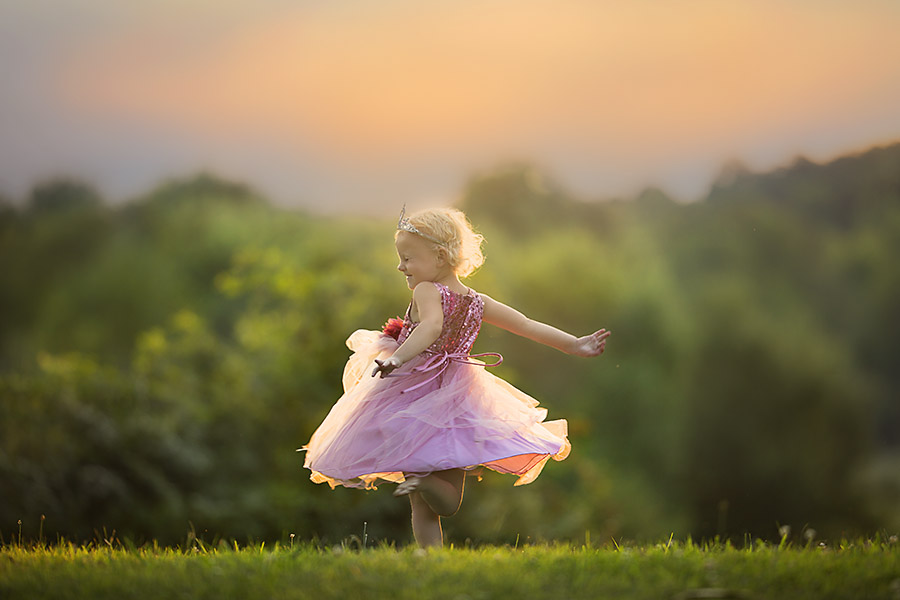
I have photographed a LOT of children in my career as a photographer; from client’s children, to friend’s children, to my own four children. I absolutely adore photographing children. Until you have photographed a rambunctious toddler, I don’t think you fully appreciate how nice it is to have a model that will stand still and follow your directions.
Children are constantly moving, curious, and off on the next adventure. And, it definitely presents some major challenges for even the most experienced photographer. Most children (especially babies and toddlers) do not want to sit still for very long and get bored with the camera quickly. So, you really have to work hard to capture their attention and keep them in one position long enough to get a good shot.
The sense of accomplishment I feel when I have captured that perfect shot of a child makes it worth all the hard work.
Please be aware that this blog post may contain affiliate links. I may earn a small commission (at no extra cost to you, I promise!) to help me keep this blog running if you use these links to make a purchase. And as an Amazon Associate I earn from qualifying purchases. Please note that I only recommend tools that I personally use and love and I always have my readers’ best interest at heart.
TIMING
As I just said, kids don’t want to sit still and look at the camera for very long. At first they might be curious about the camera and this is something you must take advantage of. Try to get shots of the children as quickly as possible (don’t rush, but manage your time as efficiently as possible).
Typically, when I do a family portrait session, I will do some portraits of just the children, some of the entire family together, and then a couple of shots of just the parents together. I always, always photograph children first. Everyone’s clothes are still looking fresh and the parents still have energy to run after their children.
By the end of the session, the kids have usually lost all interest in the camera and this is the perfect time to let them run and play while I take a few shots of the parents together. Always think about who you are photographing and how you can arrange shooting your session as effectively as possible.

These little girls’ dresses were perfectly pressed at the beginning of our session, but were covered in leaves by the end. I am so glad I got this shot at the start!
PATIENCE
Nothing will shut down a child faster than being scolded by their parents. Once that happens, their mood instantly shifts and you just see the light go out of their shining, little eyes. If a child feels embarrassed or reprimanded they will often shut down, dig their heels in, and refuse to come out of their shell again. Or worse, they will cry. Once children start to cry their faces can become red, blotchy and swollen. Sometimes that is impossible to edit out later.
Whether you are photographing your own children, or working for a client, patience is absolutely key. Believe it or not, there may have been a time or two (ok…many times!!!) when I lost my temper while photographing my own sweet angels (more like little devils).
Photographing my own children has taught me great patience. It took me a while to figure this out, but once I did, it changed everything. When you begin to photograph children, you quickly learn that it is not as easy as you originally presumed. It is definitely an eye opener. I used to get frustrated when my own children wouldn’t sit still or look at the camera. And there were times when I definitely lost my temper and yelled at them to look at the camera already!!!

I made the mistake of getting frustrated with my daughter when she wouldn’t listen and she didn’t want to pose for me for the rest of the evening. I felt terrible!
It is so much easier to speak harshly to our own children because, obviously, we know them very, very well (unlike a client’s child), and we also know what they are capable of. For example, I know for a FACT, that my eight year old is completely capable of standing still and looking at the camera. However, my two year old son gets easily distracted and finds this very difficult. But if I can remain calm and keep the mood light, fun, and upbeat, it always pays off in the end. If I loose my temper, then I can be assured the shoot is over.
When I photograph children for clients, I always take some time at the beginning of the session to explain how important it is to let the kids have fun and feel relaxed. It is very difficult having a stressed out parent hovering over your shoulder yelling at their child to sit up straight, look at the camera and smile.
USE PROPS AND VISUALS
I will often use props if I need to reign in a wild toddler who just wants to run. I have a little, white chair which is my favorite go to for these types of children. As soon as I bring it out, the child immediately wants to sit in it. But I have to remember to work quickly, because I know their fascination will not last long.

This white chair has been a tried and true photography prop. I love how my subject is “interacting” with the chair while she poses.
Just giving a child a place to sit or stand helps them focus. You can use these spot markers like these or you can even cut out your own fun shapes (think stars or hearts) from simple felt fabric, or even paper if you are in a pinch, and have the children to stand on them. This gives them something visual so they know where to stand and the kids always seem to get such a kick out of it. They use these stars in my daughter’s ballet class and it is genius! The kids go exactly where the instructor tells them because they are so excited to have their own star to stand on.
There are lot of different kinds of props that you can use when you photograph children. I have used toys, (like this adorable, little, wooden pull toy you can find here) books, baskets, hats and much more. Props help children focus and they add to the story of your photograph. I will often tell clients to bring meaningful props, such as a favorite toy or book, so that it will be a fond memory when they look back at the photo in the years to come.
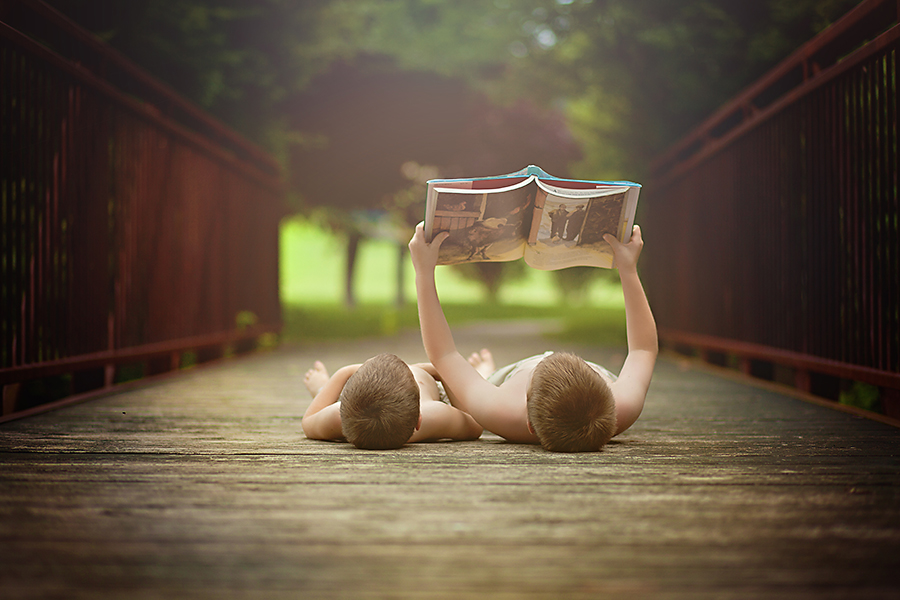
These boys brought their favorite bedtime story to use as a prop for their photo session.
EYE CONTACT
Before I dive into this topic I must say that I am a firm believer that all photos do not need to have eye contact with the camera. Some of my very favorite photos do not have eye contact. But if I want it, I use a combination of several different techniques when I photograph children. I find I usually end up pulling a couple out by the end of every session.
Toys or puppets are great for little children. I will either have my assistant or a parent stand behind me and hold the toy right over my shoulder. You want your toy as close to your lens as possible (without getting in the way of course) so that you can get a great shot of those little eyes.
For babies and very young toddlers a lens buddy or shutter hugger (its like a stuffed animal that goes around your lens) is great for giving the child something to focus on and it gets them looking right down the barrel of your lens. I also try not to hide behind my lens the entire time I am photographing very small children. I find popping your face out from behind your camera with a big smile (almost as if you were playing peekabo) is very effective. If your subject isn’t used to seeing a camera, it can be a little intimidating when it is right in their face. You may need to give them a little time to warm up to the camera.
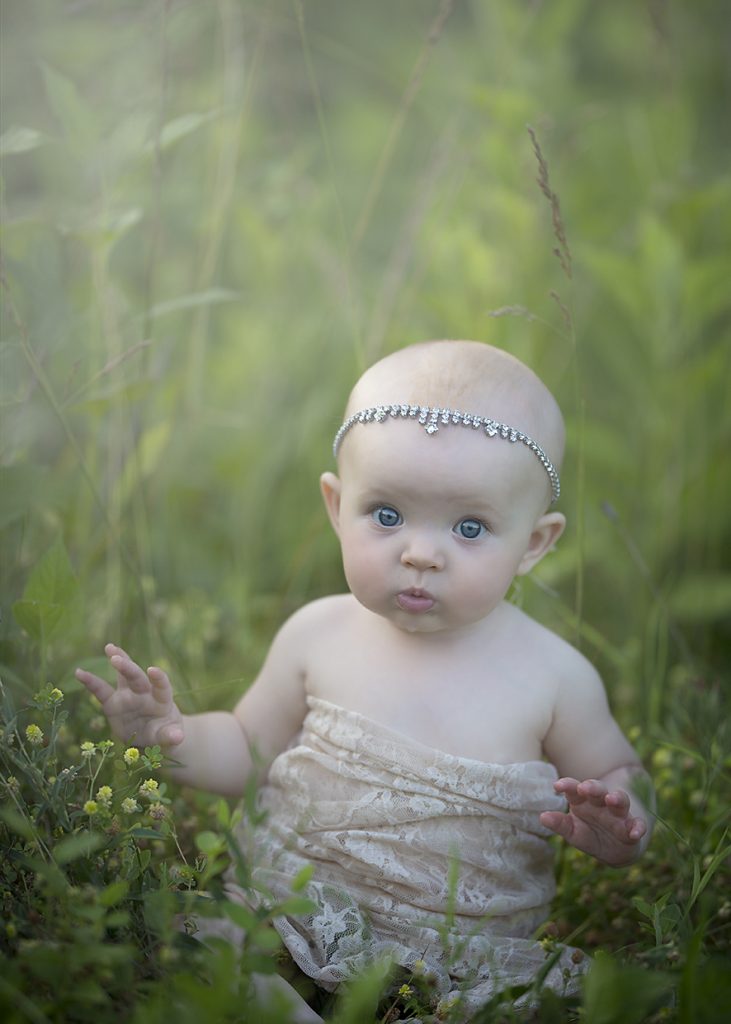
This sweet baby gave me amazing eye contact. She was fascinated with my camera and I worked quickly to get this shot.
For slightly older children, I will often ask them what they see in my lens? Can you see the dinosaur in my lens? Can you see me through the lens? This often gets them to give me a good long stare. Try connecting with your subject and making them feel joy. Maybe tell a funny story or joke. I find that this often brings about the most authentic facial expressions.
Whatever you do, don’t just repeat the child’s name over and over again to try to get them to look at you. I’m sure if you have kids of your own, then you know that they will tune you out very quickly.
SMILES
My own children have really tested me with this one. My oldest child just wants to give me a death stare most of the time and her younger sister is the biggest cheeser ever. I always tell them I want something in the middle LOL!
When a child is having a hard time giving me a believable smile, this is what I do. I tell them to close their eyes and relax their face like they are asleep. Then I say open your eyes (I take a shot). Ok give me a tiny smile (take a shot). Ok a little bigger now (take a shot). And now really big!! (take a shot). Repeat from the beginning. After a couple of cycles I usually get a few smiles that are right where I want them. It also gives the child something to do/focus on while we are shooting instead of just standing there smiling. It turns it into a little game.
And last but not least, if I am working with an older child (I often use this on adults too), I will tell them to throw their head back and give me a great big fake laugh. Nine times out of ten they will actually begin laughing at themselves and how silly they feel. I cannot tell you how many great shots I have gotten with this technique!
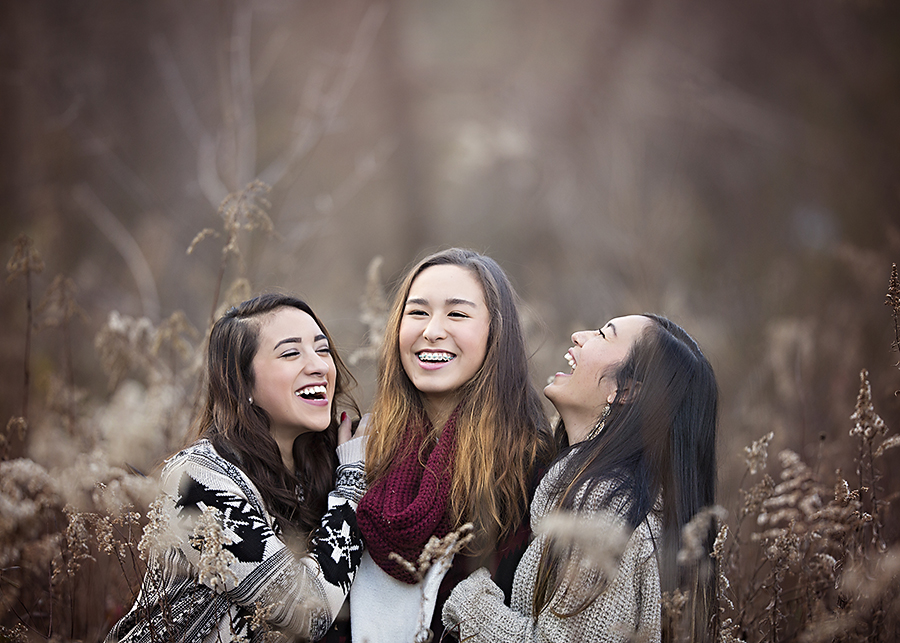
This technique works likes magic. These sisters could not stop laughing!
INTERACTION/ACTION
If you are struggling with a really energetic child sometimes you have to go for the action shots. Take photographs of them running, jumping or picking flowers. Let them run free for a few minutes, follow along with your camera, and nine times out of ten your patience will be rewarded. Your perfect shot often happens in a split second and if you are patient you will be prepared when it happens.
Get down on their level!
It is also important to get down on their level. For the shot below I literally just laid down on the ground and waited for my shot. When you get down to the eye level of your subjects, you are able to see the world through their eyes and it will come through in your photographs.

These boys were a ball of energy. I gave them breaks to “cool off” and got this great shot of them playing.
If you are photographing more than one child, having them interact or hold hands can turn out truly magical. Other times, you may have to bring a parent into the mix. Have the child give their parent a kiss. Or have Dad put them up on his shoulder, anything to get the child happy and excited. A photograph of a laughing child will usually always bring their parents joy.
TREATS
Ok, I really try to use this as a last resort, but sometimes it is necessary…maybe a little more so with my own kids because they really know how to work the system. Obviously you will know your subjects better than I will, so use your own judgement.
Whenever I photograph children I always have some waters, juice boxes, and maybe some organic fruit gummies tucked in the trunk of my car. I try to always buy organic because I never know how a parent feels about giving their child sweets. It can be a touchy subject and organic treats always seem to be better received. Plus they don’t have things like artificial chemicals or dyes to which some children can be sensitive.
If a child is really having a difficult time then I will often suggest we take a little break, have a snack and just chill or a few minutes. Often times this is enough to distract a child and get them back on track.
I used to make the mistake of trying to offer a treat to a child if they smiled for the camera. However, I have found that this really doesn’t work out well because you waste so much time in between each shot waiting for the child to chew the piece of candy.
Be sure not to choose a messy treat because it will end up all over their faces. I once made the mistake of giving my own daughter a blue piece of candy and it ended up ruining the photographs. Her lips and tongue were blue and nothing I did in photoshop was able to fix it to a point that I was happy with. Lesson learned!
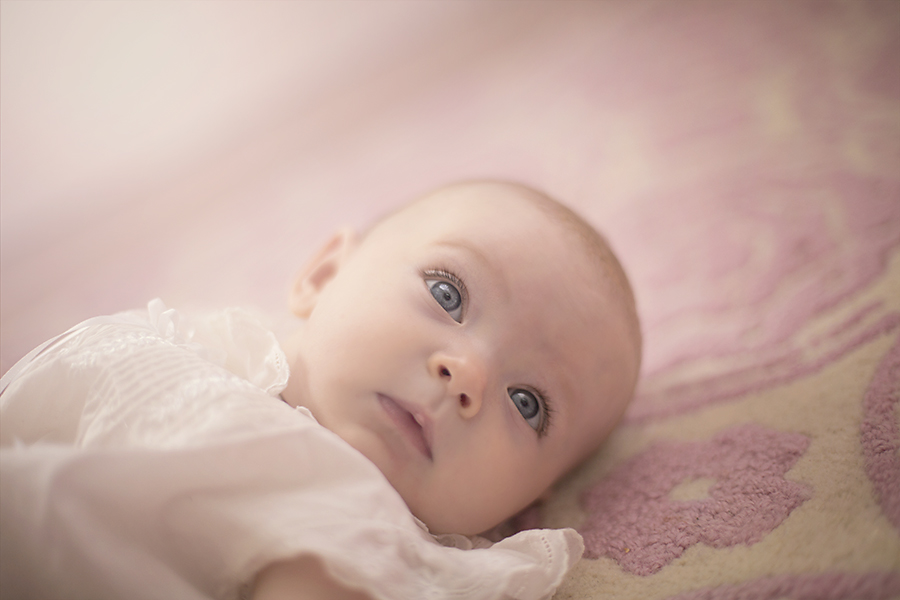
So there you have it! Photographing children can really test your limits. If you find you are having a hard time, know that you are not alone. Learning to photograph children can be challenging, but immensely rewarding when done well.
These are my go to tricks that I use whenever I photograph children, whether I’m shooting for a client or just photographing my own children. They have been a life savor! Some of them I definitely had to learn to that hard way. I hope that by sharing this you are one step ahead of the game! Good luck!
XO
Ruth
Be the first to comment